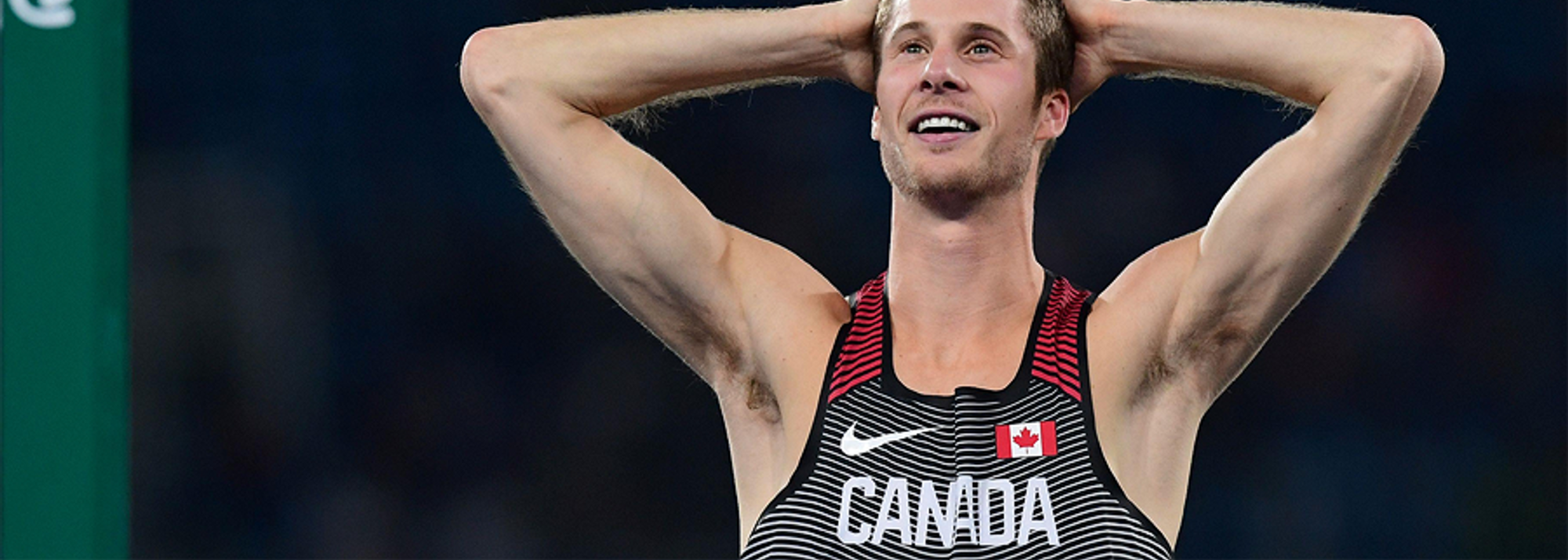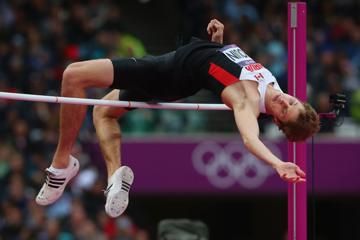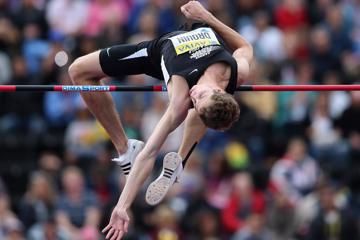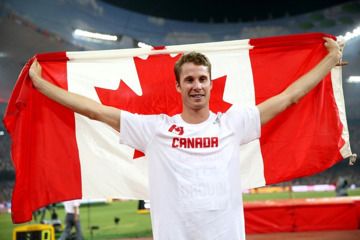Derek Drouin after winning the high jump at the Rio 2016 Olympic Games (© AFP / Getty Images)
When Derek Drouin soared to gold at the Rio 2016 Olympic Games courtesy of a flawless record up to and including his winning height of 2.38m, it seemed hard to imagine the difficult road he had taken to stand tall at the top of the podium.
Yet only three months earlier, the laid-back Canadian received the kind of blow which would have crushed many athletes after an MRI scan revealed he had a double stress fracture of the back.
“I had been duelling with the problem since January," said Drouin, who subsequently had to cut short his indoor season. "But I did not find out until shortly after the Doha Diamond League meet [where he had placed fifth with 2.29m] that I had two fractures.”
This was not, however, a time to panic as Drouin took on a typically measured and positive approach to the challenges he faced.
“I was optimistic that if I did everything people told me to do, it was going to be fine,” he explains. “I was confident I could deal with the pain. I only needed to get to Rio, where I knew the adrenaline and the competition would mask any pain.
“Certainly there were times when I did wonder whether I would get to Rio or how healthy I would be. I think overall I stayed pretty optimistic. It may at times have felt like false hope, but over time it started to turn around.”
Of course, as history taught us, the 1.94m tall Drouin is a man to be trusted in the face of adversity.
On top of the world
Back in 2015, it was not injury issues but coaching dynamics which had contributed to a slump in form and confidence. At the end of 2014 – a season when Drouin secured the Commonwealth title and leapt a Canadian record of 2.40m – his long-time coach Jeff Huntoon left their coaching base in Indiana to take up a new position at Athletics Canada’s East High Performance Hub in Toronto. Drouin opted to stay put in the US, but the long-distance coaching arrangement was clearly not working.
“For a lot of reasons this was very difficult and the way I was feeling in April-May of 2015, I knew I didn’t want to feel that way in the April-May of an Olympic year.
“I’m disciplined enough to do the workouts on my own, but in such a highly technical event you really need eyes on you at every practice and when we were far apart this was happening too infrequently.
“It might have been a little easier if I was someone who watched (jumping) videos all the time, but I’m not. I’ve always done everything on feel through my entire career, so I always need someone to help me out.”
Coupled with that, Drouin and Huntoon acknowledged that to seriously challenge for the world record (belonging to Cuba's Javier Sotomayor at 2.45m) then more speed would need to be injected into the Canadian’s run-up. Making these technical changes without a coach was proving near-impossible.
The pair made steps to remedy the situation. Leading into the Pan American Games, which were handily held in Toronto, Huntoon and Drouin reunited for a period and ahead of the IAAF World Championships Beijing 2015, the pair spent a period working in a pre-camp together.
Drouin’s confidence grew and last August he triumphed in a three-way jump-off to strike gold with 2.34m in Beijing.
“If someone has told me in May or early June (2015) that I would win the world title, I would have been very surprised, yet over time it became something I thought was possible,” he admits.
Learning the lessons of the difficult 2015 campaign last October, Drouin relocated to Toronto to work alongside Huntoon on a daily basis. Although the move had gone well, the double stress fracture threatened to derail his ambitions for Rio.
Mind control
Yet the Canadian is one tough cookie. Regarded as one of the mentally toughest competitors on the high jump circuit, he refused to lose his self-belief.
To further bolster his mental resources, he connected with a sports psychologist for the first time in his career – JF Menard – who helped guide Drouin through a sometimes difficult year.
After taking three weeks complete rest following the double stress fracture, he gradually started to feel better. He returned to competition in July but a series of modest performances were a concern.
“I started to feel like my old self, but this wasn’t necessarily translating into high heights,” says Drouin, who finished seventh at the IAAF Diamond League meeting in Monaco in mid-July with a best of 2.27m.
Yet within 48 hours something clicked. In Eberstadt he leapt a season’s best of 2.38m and any doubts had been erased.
The final piece in the jigsaw became apparent several days before Drouin was due to compete in the high jump qualification in Rio. He woke up in the Olympic Village one morning having dreamed he had struck Olympic gold. He initially felt 'relieved' before a jolt of reality hit him like a thunderbolt.
“When I quickly realised it was a dream, I remember thinking, 'why am I relieved and so happy this is over?' I have grown up my entire life dreaming of going to the Olympic Games, yet here I am wishing it away. I had to stop wishing this was over and enjoy the moment.”
Adopting a new more relaxed 'excited-to-be-there' attitude proved the perfect recipe for success.
After comfortably qualifying for the final, Drouin was a picture of calm focus in the medal battle. Unlike at the London Olympics four years before when he was simply delighted to take bronze, this time his sole desire was gold.
“I had it in my mind that 2.40m was what it would take to win this thing,” explains Drouin. “I didn’t sigh that relief when there were just three people left in the competition because my goal was not to get on the podium, it was to win. My thought process never changed and I knew any mistake could cost me gold.”
He made no mistakes – at least not when it counted – with six first-time clearances up to and including 2.38m. He simply strangled the life out of the opposition. With gold assured, he made one unsuccessful attempt at 2.40m, but it mattered not.
“When you dream about something for so long, it is really hard not to feel a flood of emotions go through you,” he says. “Just five seconds before I found out (I had won gold) I was gung-ho that I was going to clear 2.40m – then it hits you like a tonne of bricks. It was amazing, it was a feeling I will never forget. Winning gold was probably one of the most powerful waves of emotions I’ve ever felt.”
Looking to the future
World and Olympic champion, not to mention Pan American and Commonwealth champion, Drouin has the complete set of outdoor titles. It is tempting to ask what next for the 26-year-old, who hails from the small Ontarian township of Corunna.
Of course, he would love to start the defence of his title with the IAAF World Championships London 2017, yet as a man with an indoor heptathlon PB of 5817, he feels he also has some combined events ambitions to fulfil.
“I don’t feel I’m done with the combined events, whether that is an indoor heptathlon or outdoor decathlon, I’d love one day to compete for Canada,” he explains. “The unofficial, but not written, target would be to compete at the Commonwealth Games. I think I could score more than 8000 (in the decathlon), but in the past I’ve been much better at the indoor heptathlon. I really have no idea what I could score, but I’m excited to find out.”
With a mental approach to the sport many would envy, anything is possible.
Steve Landells for the IAAF








